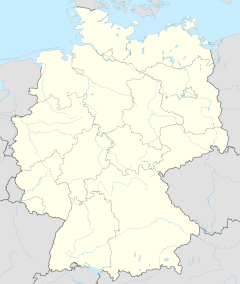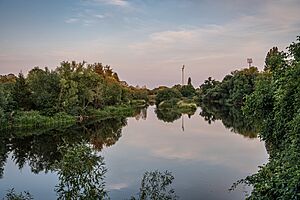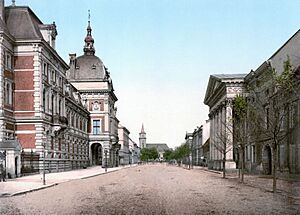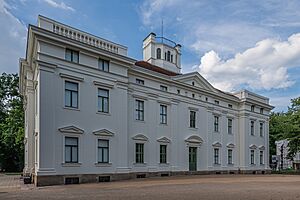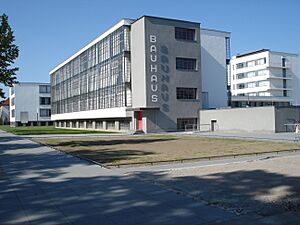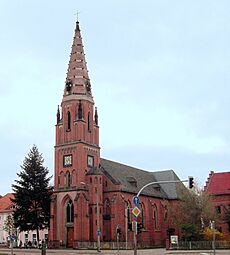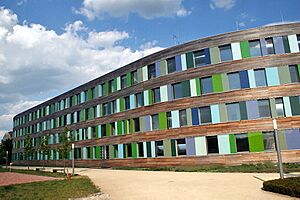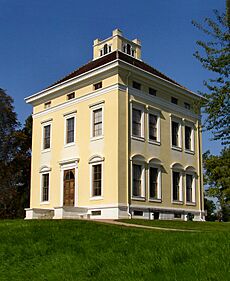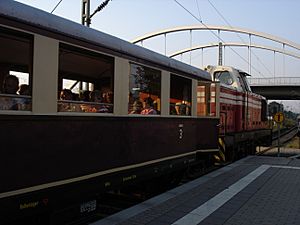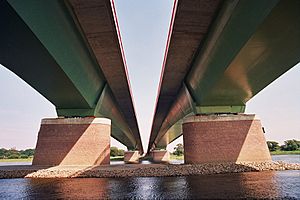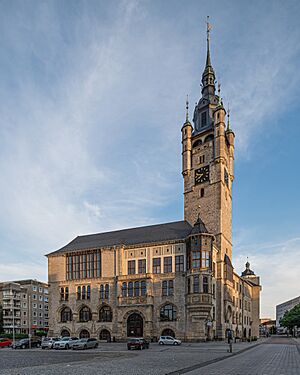Dessau facts for kids
Quick facts for kids
Dessau
|
||
|---|---|---|
|
Stadtteil of Dessau-Roßlau
|
||
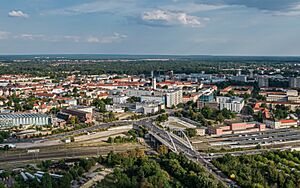
Aerial view 2022
|
||
|
||
| Country | Germany | |
| State | Saxony-Anhalt | |
| District | Urban district | |
| Town | Dessau-Roßlau | |
| Area | ||
| • Total | 182.81 km2 (70.58 sq mi) | |
| Elevation | 61 m (200 ft) | |
| Population
(2020-12-31)
|
||
| • Total | 67,747 | |
| • Density | 370.587/km2 (959.82/sq mi) | |
| Time zone | UTC+01:00 (CET) | |
| • Summer (DST) | UTC+02:00 (CEST) | |
| Postal codes |
06811-06849
|
|
| Dialling codes | 0340 | |
| Vehicle registration | DE | |
| Website | www.dessau.de | |
Dessau is a cool city in Germany, located where the Mulde and Elbe rivers meet. It's part of the state called Saxony-Anhalt. For a long time, Dessau was its own city, but since 2007, it's been part of a bigger city called Dessau-Roßlau. About 67,747 people live here (as of December 2020).
Contents
Exploring Dessau's Nature and Rivers
Dessau is built on a flat area where the Mulde River flows into the Elbe River. Because of this, the city sometimes experiences floods. The biggest flood happened in 2002, when a part of the city called Waldersee was almost completely underwater.
South of Dessau, you'll find a beautiful forest area known as Mosigkauer Heide. The highest point in Dessau is a 110-meter-high hill called Scherbelberg. It used to be a rubbish dump! Dessau is also famous for its many parks and palaces, making it one of the greenest cities in Germany.
A Journey Through Dessau's History
Dessau was first mentioned way back in 1213. It became a really important place in 1570 when the Principality of Anhalt was created. Dessau was the capital of this state within the Holy Roman Empire.
Over time, the state was divided into smaller parts. Dessau became the capital of a mini-state called Anhalt-Dessau. In 1863, these smaller parts came back together to form the Duchy of Anhalt. From 1918 to 1945, Dessau was the capital of the Free State of Anhalt.
The Famous Bauhaus School in Dessau
Dessau is very well-known as the second home of the famous Bauhaus school. This art and design school moved to Dessau in 1925 after it had to close in Weimar. Many famous artists taught here, including Walter Gropius, Paul Klee, and Wassily Kandinsky.
However, in 1932, the local government forced the Dessau Bauhaus to close. The school then moved to Bernau bei Berlin and finally closed for good in 1933.
Dessau During and After World War II
The city was almost completely destroyed by air attacks during World War II on March 7, 1945. This happened just six weeks before American troops arrived. After the war, Dessau was rebuilt using a common style from East Germany, with many concrete buildings. It became a big industrial center. Since German reunification in 1990, many of Dessau's historic buildings have been beautifully restored.
Famous People from Dessau
Dessau is the birthplace of some very famous people. The composer Kurt Weill was born here. Every year since 1993, the city hosts a festival in his honor. The philosopher Moses Mendelssohn was also born in Dessau in 1729. Another important person was Leopold I, Prince of Anhalt-Dessau, born in 1676. He was a respected military leader for the Kingdom of Prussia.
Amazing Places to See in Dessau
Dessau has many interesting sights, from beautiful gardens to unique buildings.
Castles and Gardens to Explore
- The Garden Kingdom of Dessau-Wörlitz is a World Heritage Site. It's a fantastic example of 18th-century English-style landscape design.
- You can also visit the Zoo at Mausoleumspark.
- There are remains of the old Dessau Palace (Johannbau).
- Explore beautiful palaces and parks like Georgium, Kühnau, Mosigkau, and Luisium.
The Unique Bauhaus Architecture
Dessau is home to several amazing examples of Bauhaus architecture. Some of these are even part of the Bauhaus and its Sites in Weimar, Dessau and Bernau World Heritage Site. The Bauhaus Dessau school building, designed by Walter Gropius, is a very famous modern building.
Other cool Bauhaus buildings in Dessau include:
- The Dessau-Törten Estate, designed by Walter Gropius.
- The Stahlhaus (Steel House), designed by Georg Muche and Richard Paulick.
- The Fieger Haus, designed by Carl Fieger.
- The Kornhaus, a restaurant with a great view of the Elbe River, also designed by Carl Fieger.
- The Arbeitsamt (Employment office), designed by Walter Gropius.
Historic Churches in Dessau
Dessau has many churches with interesting history and architecture, such as:
- St. Mary's Church
- St. John's Church
- Georgenkirche
- Propsteikirche St. Peter and Paul
Other Interesting Sights
- The Town Hall, built in 1901.
- The palaces of Waldersee and Dietrich, which are now used as libraries.
- The General Post Office.
- The New Water Tower.
- The Umweltbundesamt (Federal Environment Agency).
- A footbridge that crosses the Mulde River.
Culture and Entertainment in Dessau
Dessau offers a variety of cultural experiences, from theaters to museums.
Theaters and Museums to Visit
- The Anhaltisches Theater is a major theater in the city.
- You can learn about the city's past at the City History Museum.
- The Anhalt Art Gallery at Georgium Palace has a great art collection (though it might be closed sometimes).
- Explore the Mosigkau Palace museum and the Luisium Castle museum.
- The Hugo Junkers Technical Museum is a must-see for anyone interested in engineering.
- If you like movies, there's the UCI Cinema Complex and the Kiez-Cinema, which is one of Germany's smallest cinemas!
Getting Around Dessau
Dessau has good ways to get around, whether by tram, train, or bike.
Public Transportation in Dessau
The Dessau tramway network has three lines, and there are also many bus lines. The local transport company, Dessauer Verkehrsgesellschaft (DVG), helps about 6 million people travel each year.
Train Connections
Dessau's main train station, Dessau Hauptbahnhof, connects to cities like Magdeburg, Berlin, Leipzig, and Halle. The train line from Berlin opened in 1840. The line to Bitterfeld was electrified in 1911, making it Germany's first fully electric long-distance railway!
You can also take the Dessau-Wörlitzer-Eisenbahn (railway) to Wörlitz, a town with a beautiful park.
Roads and Highways
The autobahn A9 (Munich-Berlin) was built near Dessau in 1938. Dessau also has federal roads, the B 184 and B 185, that cross through the city.
Dessau Airfield
Dessau has its own airfield (ICAO: EDAD) where charter planes can land. The runway is 1000 meters long. The Hugo Junkers Technical Museum is right next to the airfield, which is cool because it's near where the historic Junkers factory airstrip used to be.
Waterways and Bikes
The Leopoldshafen harbor is used for exciting international motorboat races every year. There's also a private harbor for pleasure boats. Dessau is in a flat area, so it's great for biking! The city has about 146 km of bike paths connecting all the main parks and sights.
Sports and Fun in Dessau
Sports are very popular in Dessau, with a long history in many different activities.
Popular Sports and Clubs
Sports like soccer, cycling, handball, and gymnastics are very popular here. The former soccer team SG Waggonbau Dessau even won the GDR soccer cup in 1949! Dessau has about 80 sports clubs with over 13,500 members.
Besides traditional sports, you can find clubs for aikido, badminton, basketball, canoeing, chess, climbing, and many more!
Sports Facilities
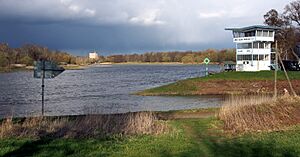
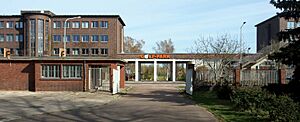
Dessau has many places to play sports:
- Over 10 sports fields
- 6 skittle alleys
- 3 tennis courts
- 2 indoor swimming pools
- The Paul-Greifzu-Stadion (which can hold 22,000 people)
- A speedskating course
- The Zuckerturm climbing tower
- The Anhalt Arena Dessau (which can hold 3,600 people)
- The Dessau Airfield
- A rifle range
How Dessau is Governed
Dessau's local government has changed over many centuries. In the past, a leader called a Schultheiss and a council managed the town. Since 1852, the town leader has been called the mayor.
After World War II, a new executive council was formed. Today, the city council (called the Stadtrat) is freely elected by the people. Since 1994, the mayor is also directly elected by the people. In 2007, Dessau became part of the larger municipality of Dessau-Roßlau.
Current Mayor
Peter Kuras was elected mayor of Dessau-Roßlau in 2014 for a seven-year term.
Dessau's Sister Cities
Dessau has special partnerships with other cities around the world. These are called "town twinnings" or "sister cities."
|
|
Learning and Education in Dessau
Dessau has several important educational institutions:
- Anhalt University of Applied Sciences, where students can study architecture, design, and more.
- Vocational schools like the Anhalt Vocational School Centre Hugo Junkers.
- Grammar schools such as Walter Gropius Grammar School and Philantropinum Grammar School.
Gallery
See also
 In Spanish: Dessau para niños
In Spanish: Dessau para niños



